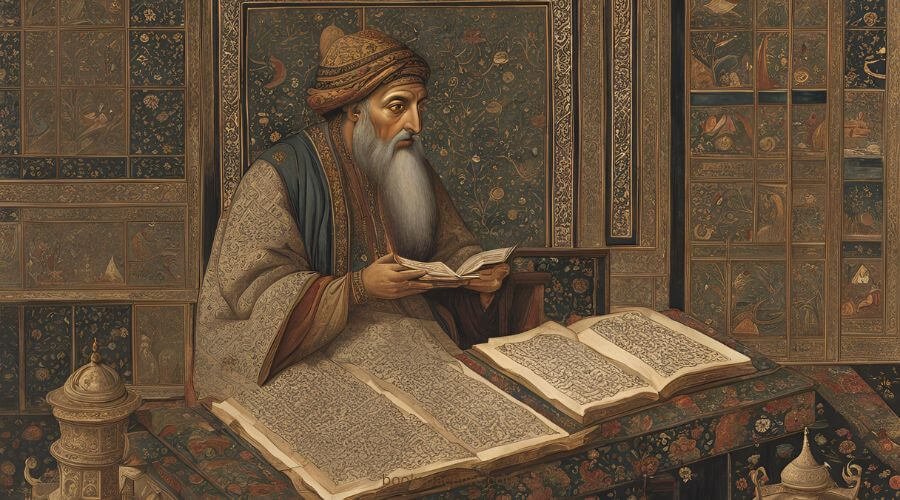Philo of Alexandria
Al-Shahrastani: The Philosopher of Religious Pluralism and Intellectual Curiosity
Al-Shahrastani (1086–1153 CE) was a brilliant Islamic philosopher, theologian, and historian whose work spanned a wide array of intellectual disciplines, including Islamic theology, philosophy, logic, metaphysics, and religious studies.
Renowned for his scholarly depth and eclecticism, Al-Shahrastani’s contributions to medieval Islamic philosophy and theology continue to resonate in contemporary discussions about religious pluralism, metaphysics, and the nature of human knowledge.
His most famous work, The Milal wa al-Nihal (“The Book of Religions and Sects”), stands as a monumental study in comparative religion and philosophical inquiry.
This blog post will explore Al-Shahrastani’s life, travels, education, philosophy, influence, and impact on intellectual history.
Table of Contents
(1) Early Life and Education
Al-Shahrastani was born in Shahrastan, a town in present-day Iran, in 1086, during the period of Seljuk rule.
His full name, Abu al-Fath Muhammad ibn ‘Abd al-Karim al-Shahrastani, reflects his heritage, and his early education was deeply influenced by the rich intellectual climate of the Islamic world during the medieval period.
As a young man, Al-Shahrastani was exposed to both the religious teachings of Islam and the intellectual traditions of Greek philosophy that had been preserved and expanded upon by earlier Muslim philosophers, such as Al-Farabi, Ibn Sina (Avicenna), and Ibn Rushd (Averroes).
Al-Shahrastani was particularly drawn to the study of Islamic theology (kalam) and philosophy, and he sought out the best scholars of his time to deepen his knowledge.
He studied Islamic jurisprudence, theology, logic, and philosophy under renowned scholars in Baghdad, Damascus, and Isfahan, regions known for their vibrant intellectual and cultural centers.
His exposure to various schools of thought, including the Ash’ari school of Islamic theology and the Mu’tazili school, played a crucial role in shaping his intellectual identity.
At the same time, Al-Shahrastani was influenced by Peripatetic philosophy and the writings of Aristotle and Plato, which had been interpreted and modified by Islamic philosophers.
His familiarity with these traditions, combined with his deep immersion in Islamic thought, helped him develop a unique and nuanced perspective on the relationship between reason, faith, and the nature of the divine.
(2) Intellectual and Spiritual Journeys
Al-Shahrastani’s intellectual journey led him on travels across the Islamic world.
His life was marked by a broad and diverse range of encounters with different religious, philosophical, and theological communities.
His travels brought him into contact with various philosophical schools, including Sufism, Shi’ism, and Ismailism, all of which influenced his philosophical writings.
Al-Shahrastani’s journey also took him to regions where Hellenistic philosophy and its Islamic interpretations were flourishing.
This exposure to various intellectual and religious traditions significantly enriched his philosophical insights, and his extensive engagement with both Islamic and non-Islamic thought resulted in a distinctive blend of ideas from different cultures.
In particular, his work reflects a deep interest in understanding the multiplicity of religious traditions, their doctrines, and their internal logic.
His intellectual curiosity knew no bounds, and he sought to understand and explain the diversity of human belief systems.
(3) Philosophy and Theological Views
Al-Shahrastani’s most famous work, The Milal wa al-Nihal, provides a comprehensive survey of the various religious sects, schools of thought, and philosophical traditions that existed in the Islamic world during his time.
In this work, Al-Shahrastani examines the theological and philosophical foundations of different religious communities, including Muslims, Jews, Christians, Zoroastrians, and Hindus.
His approach is highly systematic, detailing the core beliefs and practices of each sect while offering critiques of their doctrines from an Islamic perspective.
(i) Religious Pluralism
One of the most striking features of Al-Shahrastani’s philosophy is his commitment to religious pluralism.
Unlike some of his contemporaries, who viewed non-Islamic religious systems as heretical or misguided, Al-Shahrastani took a more inclusive approach.
He sought to understand the truths within various religious traditions, acknowledging their intellectual and spiritual contributions while maintaining an Islamic viewpoint.
His comparative approach to religion allowed him to see commonalities between diverse belief systems, and he even suggested that many non-Islamic religions shared essential truths about the divine, albeit in a distorted or incomplete form.
Al-Shahrastani’s philosophy of religious pluralism is rooted in his belief in the unity of divine truth, which transcends individual religious communities.
He argued that, while each religion might express its understanding of the divine in different ways, they all point toward a single, overarching truth.
This stance places him among early thinkers who advocated for tolerance and understanding between religious traditions, a position that resonates with modern discussions on religious diversity.
(ii) Theology and Cosmology
In addition to his work on religious diversity, Al-Shahrastani made significant contributions to Islamic theology and cosmology.
He was deeply influenced by the Ash’ari school of theology, which emphasized the omnipotence and transcendence of God.
However, Al-Shahrastani was also critical of certain theological positions, particularly those of the Mu’tazilites, who advocated for a more rationalistic approach to theology.
Al-Shahrastani’s critique of the Mu’tazilites reflects his belief in the limits of human reason in understanding the divine.
Al-Shahrastani’s cosmology, influenced by Avicenna and Neoplatonic thought, presents a view of the universe in which the divine, through a process of emanation, creates the world in a series of hierarchical stages.
This cosmological framework reflects his belief in the oneness and unity of the universe, with all things ultimately emanating from the divine source.
(iii) Logic and Metaphysics
Al-Shahrastani’s contributions to logic and metaphysics are equally noteworthy.
He wrote extensively on syllogistic reasoning, dialectic, and the nature of existence. His works on logic were highly regarded in the Islamic intellectual tradition, and his ideas were studied by later philosophers such as Ibn Rushd (Averroes).
Al-Shahrastani’s metaphysical writings reflect his synthesis of Aristotelian philosophy and Islamic thought, particularly the concept of God as the First Cause and the source of all being.
(4) Influence and Impact
Al-Shahrastani’s work has had a lasting influence on both Islamic and Western intellectual traditions.
His contributions to comparative religion, theology, and philosophy continue to be studied by scholars interested in the history of Islamic thought and the development of religious and philosophical discourse.
(i) Influence in the Islamic World
Within the Islamic world, Al-Shahrastani’s work had a significant impact on later thinkers, especially in the fields of Islamic theology and philosophy.
His comparative approach to religion and his critique of various sects were widely studied by later Muslim scholars.
His work on Sufism also influenced the development of mysticism within Islam, as it provided a theological foundation for understanding the spiritual practices of mystics and dervishes.
(ii) Impact on Western Thought
Though Al-Shahrastani’s influence on Western thought was more indirect, his writings on philosophy, particularly those dealing with logic, metaphysics, and theology, reached European intellectuals through translations of Arabic philosophical works.
His critique of rationalism and his emphasis on the limitations of human knowledge in understanding divine truths resonated with later European philosophers, especially those in the medieval scholastic tradition.
(5) Conclusion
Al-Shahrastani was a pioneering thinker whose intellectual breadth and deep understanding of both Islamic and non-Islamic traditions make him a key figure in the history of medieval philosophy.
His approach to religious pluralism, philosophy, and theology reflects a rare synthesis of intellectual curiosity, compassion for diverse religious beliefs, and a commitment to understanding the divine in all its manifestations.
Al-Shahrastani’s legacy continues to inspire scholars and thinkers across the world, serving as a bridge between Eastern and Western philosophical traditions and offering timeless insights into the nature of religion, reason, and human understanding.








